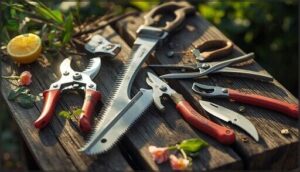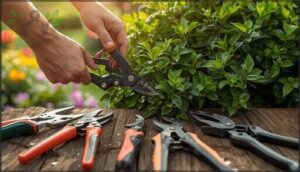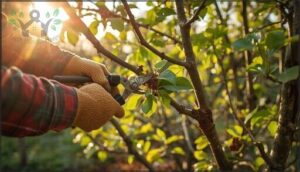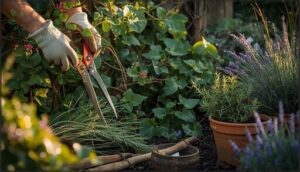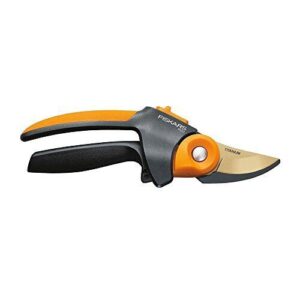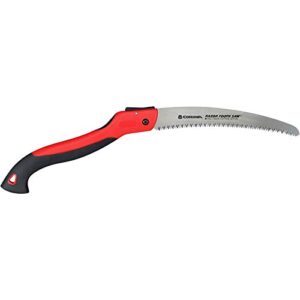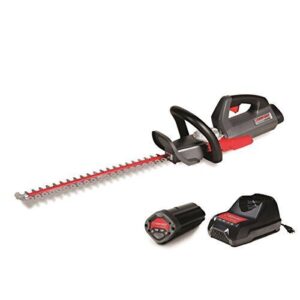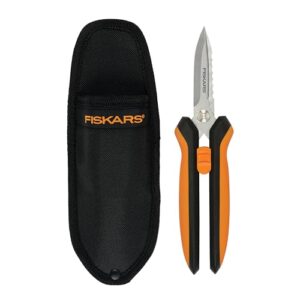This site is supported by our readers. We may earn a commission, at no cost to you, if you purchase through links.
Your rosebush sends up a tangle of crossing branches. Your tomato plant sprawls across the garden path. Your fruit tree bears small, disappointing apples. These aren’t signs of failure—they’re invitations to prune.
Learning how to prune garden plants transforms struggling greenery into productive powerhouses. The right cut at the right time redirects a plant’s energy from wasted growth into flowers, fruit, and strong structure.
You don’t need years of experience to start. You need sharp tools, basic knowledge of when and where to cut, and the confidence to make that first snip. Once you understand which branches to remove and why, pruning becomes less intimidating and more rewarding with each season.
Table Of Contents
- Key Takeaways
- Why Prune Garden Plants
- Essential Pruning Tools and Uses
- When to Prune Different Plants
- Pruning Techniques and Methods
- Step-by-Step Guide to Pruning Shrubs
- How to Prune Trees for Health
- Pruning Vines, Perennials, and Herbs
- Top 9 Pruning Tools for Gardeners
- 1. Corona ComfortGEL Hand Pruner Small Medium
- 2. Corona ComfortGEL Micro Snips for Gardening
- 3. Fiskars PowerGear Bypass Pruning Shears
- 4. Fiskars Extendable Power Lever Bypass Lopper
- 5. Corona Razor Tooth Folding Saw
- 6. Troy-Bilt CORE Cordless Hedge Trimmer
- 7. Corona Forged Hedge Shear HS 3911
- 8. TrimmerPlus Gas Powered Pole Saw Attachment
- 9. Fiskars Multipurpose Garden Shears with Sheath
- Frequently Asked Questions (FAQs)
- Can you prune during wet or rainy weather?
- How do you sterilize tools between plants?
- What happens if you prune too much?
- Do different plant ages require different pruning?
- Should you fertilize immediately after pruning?
- What angle should I cut branches at?
- Can pruning kill a healthy plant?
- How do I sterilize pruning tools properly?
- Should I seal cuts with wound dressing?
- Whats the difference between pruning and trimming?
- Conclusion
Key Takeaways
- Strategic pruning redirects plant energy from wasted growth into productive flowers, fruit, and stronger structure by removing dead tissue, diseased branches, and crossing limbs that drain resources.
- Timing matters more than technique—prune spring bloomers right after flowering to preserve next year’s buds, but cut summer bloomers in late winter when they’re dormant to maximize yields.
- Three core cutting methods control growth: thinning opens dense canopies without disrupting form, heading stimulates bushy growth by trimming branch tips, and pinching keeps soft shoots compact.
- Sharp, sterilized tools prevent disease spread between plants, with bypass pruners handling live stems up to 3/4 inch, loppers tackling growth up to 2 inches, and pruning saws cutting anything thicker.
Why Prune Garden Plants
Pruning might seem like you’re hurting your plants, but it’s one of the best things you can do for them. When done right, trimming away certain parts actually helps your garden thrive in ways you mightn’t expect.
Let’s look at the main reasons why pruning matters and how it transforms your plants into healthier, more productive versions of themselves.
Key Benefits of Pruning
Pruning delivers rewards that go beyond simple trimming. When you cut strategically, you’re unlocking your garden’s potential in ways that transform both plant performance and your outdoor space.
- Healthier plant growth through removing dead tissue that drains energy
- Enhanced structure that bolsters branches and prevents breakage
- Increased yield with up to 30% more flowers and better fruit quality
- Disease prevention by improving airflow and eliminating infected parts
Strategic pruning can also maximize sunlight penetration, leading to healthier foliage.
How Pruning Promotes Plant Health
When you remove dead and diseased branches, you stop infections before they spread. Preventing plant disease becomes easier because better air circulation keeps humidity low and fungus at bay. Light penetration improves too, boosting photosynthesis in shaded leaves.
Removing dead and diseased branches stops infections from spreading while improving air circulation and light penetration for healthier plants
Your plants direct nutrients to vigorous new growth instead of wasting energy on damaged wood. This smart nutrient allocation strengthens roots and shoots, creating resilient growth dynamics that keep your garden thriving naturally.
Regular pruning also helps to improve overall plant health.
Controlling Plant Size and Shape
Beyond health benefits, pruning techniques give you control over plant size and shape. Heading cuts reduce height by trimming back branches, while thinning techniques open dense growth without harming natural form. Re-leadering combines both methods to manage tall shoots.
Root pruning and leaf pruning complement above-ground work, maintaining plant shape by balancing growth ratios. You decide how big or compact your plants become.
Preventing Disease and Improving Appearance
Tool sterilization between cuts stops disease from spreading plant to plant. Pruning timing matters too—work during dry weather to protect fresh wounds.
Airflow improvement through material removal keeps fungal problems at bay while giving your garden a polished look.
Watch for over-pruning risks though. Removing too much weakens plants and creates sparse growth that invites trouble instead of preventing it.
Essential Pruning Tools and Uses
Having the right tools makes all the difference when you’re ready to start pruning. Each tool is designed for a specific job, from snipping delicate stems to cutting through thick branches.
Let’s look at the essential pruning tools you’ll need and what each one does best.
Hand Pruners and Snips
Your garden toolkit needs two essential pruning tools: hand pruners for stems up to 3/4 inch thick and micro snips for delicate work. Bypass pruners make clean cuts on live growth, while anvil types are suitable for dead wood under half an inch.
- Ergonomic designs with closed-loop handles reduce hand fatigue during extended sessions
- Blade materials like high-carbon steel resist rust and stay sharper longer
- Cutting techniques differ—bypass for precision, anvil for crushing tough stems
- Pruner maintenance through regular sharpening and cleaning extends tool life considerably
Loppers and Pruning Saws
When branches grow thicker than your hand pruners can handle, loppers and pruning saws become your go-to pruning tools. Loppers with ergonomic designs tackle stems from 3/4 to 2 inches using bypass or anvil cutting mechanisms.
Beyond that diameter, pruning saws excel at pruning plants with substantial growth. Market trends favor ratchet models for easier cuts. Blade maintenance through regular sharpening keeps these pruning techniques effective season after season.
Hedge Shears and Trimmers
When shaping broad sections of evergreen hedges or formal topiary, hedge shears and trimmers become essential pruning tools. Manual hedge shears offer precision and safety for small-scale work, while electric or gas-powered hedge trimmers cut branches up to 1/4 inch efficiently.
Modern trimmer safety features like dual-hand controls protect you during use. Professional insights show these tools improve cutting efficiency dramatically when pruning hedges regularly, promoting plant health through controlled shaping.
Tool Maintenance and Safety Tips
Keeping your pruning tools sharp and clean makes every cut safer and healthier for your plants. Studies show that 71% of pruning injuries are lacerations affecting hands and arms, so proper maintenance matters.
- Sharpen blades every 1 to 3 years using diamond files for clean cuts
- Disinfect tools between plants to prevent disease transmission
- Apply machine oil after cleaning to prevent rust and extend tool longevity
When to Prune Different Plants
Timing matters more than most gardeners realize. Prune at the wrong time and you might cut off this year’s blooms or leave your plant vulnerable to frost damage.
Let’s look at when to prune based on seasons, plant types, and the signals your plants send you.
Seasonal Pruning Guidelines
Timing is everything for seasonal pruning success. Each season offers unique advantages for different plants and pruning techniques, with climate impact playing a key role in when to prune plants.
Match your pruning season to your plant’s natural cycle for the healthiest results.
| Season | Best Pruning Practices |
|---|---|
| Spring Pruning | Cut back perennials and fast-growing hedges in early spring before major growth begins. Prune hybrid roses and lavender to stimulate healthy development. |
| Summer Shaping | Restrict vigorous growth and remove diseased wood. Light trimming maintains form without stressing plants during hot months. |
| Fall Preparation | Remove dead or damaged branches to reduce overwintering pests. Avoid major cuts in cold climates to prevent vulnerable new growth. |
| Winter Dormancy | Prune deciduous trees and overgrown shrubs while dormant. Bare branches reveal structure for precise cuts with minimal disease risk. |
Timing for Flowering and Fruiting Plants
Flowering and fruit production depend heavily on when you prune plants. Spring-flowering shrubs set buds on old wood, so you need to prune blooming plants right after they flower—think lilacs and azaleas. Prune too late and you’ll sacrifice next year’s display.
- Prune spring bloomers immediately after flowering to preserve next season’s buds
- Cut summer-flowering plants in late winter before new growth starts
- Time fruit tree pruning for late winter dormancy to heighten fruit yield effects
- Avoid fall pruning to prevent vulnerable new growth before winter
- Remove dead branches anytime without impacting flowering or fruit production
Summer bloomers flower on new wood, so winter pruning techniques encourage vigorous blooming. Spring pruning best practices greatly boost fruit production in many crops, while autumn timing can optimize early and late season harvests. The physiological impacts of proper timing include better hormone balance and stronger flower development.
Signs Your Plant Needs Pruning
Your plants will tell you when they need attention. Broken or rubbing branches signal immediate pruning needs to prevent further damage. Dead limbs show brown discoloration and lack leaves, while diseased branches display unusual spots or fungal growth.
Dense canopies blocking airflow, reduced flowering, or excessive foliage crowding other plants all indicate it’s time to act. Watch for these signs of health decline before problems worsen.
Pruning Techniques and Methods
The right pruning technique makes all the difference in how your plants respond and grow. Each method has a specific purpose, from encouraging bushier growth to removing spent blooms that drain energy.
Let’s look at the core techniques you’ll use throughout the growing season.
Thinning, Heading, and Pinching Cuts
Understanding the three main pruning cuts gives you real control over growth habit. Thinning cuts remove entire branches to open the canopy without disrupting auxin disruption. Heading cuts stimulate bushy growth by cutting branch tips. Pinching keeps soft growth compact by removing shoot tips with your fingers.
Each technique has distinct hormonal effects. Smart cut combinations let you balance practical applications like shape, health, and productivity in your garden.
Deadheading and Maintenance Pruning
Deadheading removes spent flowers to extend bloom periods and redirect energy toward new growth. This simple maintenance pruning technique keeps gardens looking fresh while improving plant vigor.
Remove faded blooms every few days during peak season to maintain continuous color. Regular deadheading reduces your dependency on chemical treatments and lowers long-term maintenance costs.
These garden maintenance habits deliver both aesthetic benefits and healthier plants throughout the growing season.
Hard Pruning Vs. Light Pruning
Your pruning approach depends on what you want to achieve. Hard pruning cuts plants back severely to stimulate growth and rejuvenate plants during the dormant pruning season. Light pruning involves gentler cuts for maintenance and disease prevention.
Here’s how these pruning techniques differ:
- Hard pruning dramatically reshapes overgrown plants with major structural impact
- Light pruning maintains appearance through selective trimming
- Timing varies – hard cuts during dormancy, light cuts during growth
- Both pruning methods improve airflow and reduce disease risk
Step-by-Step Guide to Pruning Shrubs
Pruning shrubs doesn’t have to feel like guesswork once you know what to look for. A few simple decisions about which branches to cut will keep your shrubs healthy and looking their best.
Here’s how to prune with purpose and get results that last.
Identifying Branches to Remove
Your shrub will tell you what needs to go if you know what to look for. Dead branch ID starts with the scratch test—healthy wood shows green underneath while dead wood stays brown. Diseased branch ID means spotting discolored bark or fungus.
Remove crossing branches that rub together and create wounds. Shaded branches with sparse leaves weaken your plant. Size control requires removing branches disrupting your desired shape.
These pruning cuts prevent disease and redirect energy where it counts.
Shaping and Thinning Techniques
With strategic cuts, you transform shrubs into healthy showpieces. Shaping cuts direct growth outward by removing inward branches at 45-degree angles. Thinning methods improve plant structure by removing entire stems at their origin.
Try these cutting techniques:
- Cut just above outward-facing buds to promote proper growth direction
- Space scaffold branches 8-20 inches apart vertically for better light penetration
- Remove oldest stems first to maintain natural form
- Thin dense canopies to boost air circulation and reduce disease risk
Preventing Overgrowth and Disease
By combining smart pruning frequency with proper tool disinfection, you’ll keep shrubs in check while preventing disease. Prune during dry weather and disinfect tools between cuts to stop pathogen spread.
Seasonal timing matters—prune in early spring to control size before aggressive growth begins. Remove diseased branches at least 10 inches into healthy tissue.
Good air circulation through thinning cuts reduces fungal problems naturally.
How to Prune Trees for Health
Trees need a different approach than smaller plants because their structure and size demand more planning. You’ll focus on removing what holds your tree back while creating space for light and air to reach every part of the canopy.
Here’s how to keep your trees strong and thriving for years to come.
Removing Dead or Damaged Branches
Dead branches are like magnets for trouble. They invite pests and disease while blocking light and air from healthy growth. You’ll want to remove them right away using clean cuts near the branch collar. This pruning technique prevents disease spread and keeps your tree strong.
The best part? You can tackle hazard branch removal anytime you spot a problem, though late winter works great for maintaining plant health.
Thinning for Air Circulation and Light
Think of your tree’s canopy like a crowded room—everyone needs breathing space. Thinning pruning techniques open up that packed canopy density, letting sunlight penetration reach inner branches and increasing air circulation throughout.
This cuts disease prevention issues by reducing moisture buildup where fungal infections love to grow. Better light penetration also boosts plant photosynthesis, making your tree more productive.
Aim for moderate pruning intensity—removing about 10 to 30 percent of branches works beautifully.
Special Considerations for Fruit Trees
Pruning fruit trees demands timing and technique that directly affect your harvest. Prune during late winter dormancy to minimize stress and improve fruit yield while avoiding cold damage to tender buds.
- Remove no more than one third of growth to prevent excessive vegetative shoots
- Maintain scaffold branches at 45-60 degree angles for structural pruning strength
- Thin upper canopy portions to improve light penetration and sweeten fruit
- Cut diseased wood 8-12 inches below infection for disease management
This growth regulation focuses energy on fruit production instead of wasteful water sprouts.
Pruning Vines, Perennials, and Herbs
Vines, perennials, and herbs each respond differently to pruning, but all benefit from regular attention throughout the growing season. You’ll use similar techniques across these plant types, adjusting your approach based on whether you’re aiming for fuller growth, seasonal renewal, or increased production.
Here’s how to prune each type to get the results you want.
Encouraging Fuller Growth in Vines
When you want fuller vines, pruning timing makes all the difference. Leader pruning increases shoot density by removing vigorous growth and opening the canopy for better light. Spur pruning keeps short spurs that produce fruitful shoots year after year.
Focus on directing plant growth by thinning unnecessary canes during dormancy. These pruning techniques help your vines develop stronger, more abundant growth.
Cutting Back Perennials for Regrowth
Like vines, perennial plants respond well to strategic cutting techniques. Seasonal timing determines success—cut back summer bloomers in early spring and spring bloomers right after flowering. Species variation matters because hostas tolerate fall pruning while catmint rebounds for a second show.
Regrowth benefits include:
- Increased plant vigor and healthier foliage
- Extended bloom control through the season
- Reduced disease by removing old stems
- Denser, bushier growth habits
Encouraging plant growth starts with clean cuts at ground level.
Pruning Vegetables and Herbs for Production
Vegetables and herbs demand different attention than ornamentals. Tomatoes benefit from removing lower branches to direct energy toward fruit, while peppers pruned to four stems produce higher marketable yields.
Basil needs pinching every week or two to prevent flowering and boost leaf production. Regular pruning of leafy greens and herbs increases both quality and harvest weight throughout the growing season.
Top 9 Pruning Tools for Gardeners
The right tool makes pruning easier and helps you avoid damage to your plants. Each tool has a specific purpose based on what you’re cutting and where it’s located.
Here are nine reliable options that will cover most of your garden pruning needs.
1. Corona ComfortGEL Hand Pruner Small Medium
When comfort meets cutting power, you gain control over your garden. The Corona ComfortGEL Hand Pruner handles stems up to 3/4 inch thick with its carbon steel non-stick blade. You’ll appreciate the soft ergonomic grips that reduce hand strain during extended pruning sessions.
This tool comparison shows why hand pruners remain essential among pruning tools and their uses. The integrated Shock-Guard bumpers protect your muscles while you master pruning techniques and methods.
For pruning safety and proper pruner maintenance, the sharpenable blade and corrosion-resistant design deliver seasons of reliable performance.
2. Corona ComfortGEL Micro Snips for Gardening
Precision cuts shape your garden’s finest details. The Corona ComfortGEL Micro Snips deliver that control with stainless steel blades that manage stems up to 1/8 inch thick. You’ll master deadheading and harvesting herbs while the ergonomic design reduces hand fatigue during extended sessions.
This tool fits naturally among essential gardening tools for pruning plants with accuracy. The spring-loaded grips and double-sided lock support your pruning techniques and methods while keeping blades safe.
User satisfaction remains high for delicate tasks, though durability reviews suggest reserving these snips for lighter work rather than woody branches.
3. Fiskars PowerGear Bypass Pruning Shears
Branches thicker than your thumb demand real cutting power. The Fiskars PowerGear Bypass Pruning Shears deliver it through patented gear technology that triples your force on stems up to 3/4 inch thick.
These bypass pruners rank among top-selling hand pruners with their ergonomic design featuring contoured rolling grips and SoftGrip touchpoints that reduce strain during extended use.
The hardened steel blade maintains sharpness while a rust-resistant coating prevents gumming. User experience reviews praise their balance of power and comfort, making these pruning shears essential among sharp pruning tools for serious gardeners.
4. Fiskars Extendable Power Lever Bypass Lopper
Overhead growth beyond normal reach demands leverage technology that multiplies your muscle. The Fiskars Extendable Power Lever Bypass Lopper grips branches up to 1-3/4 inches with compound action that doubles your cutting force. Its telescoping handles stretch from 25 to 37 inches for branch removal without ladders.
The hardened steel blade maintains sharpness through heavy use while the rust-resistant coating reduces friction. User comfort comes through cushioned grips and shock-absorbing bumpers. Fiskars backs these bypass pruners with a lifetime warranty, confirming their confidence in build quality.
5. Corona Razor Tooth Folding Saw
Tight spaces between branches require finesse that regular saws can’t deliver. The Corona RazorTOOTH Folding Saw carries a 10-inch curved blade with triple-ground teeth that slice through 3- to 6-inch limbs twice as fast as standard models. Its blade technology uses impulse-hardened Japanese steel that stays sharp season after season without needing sharpening.
Ergonomics matter during extended pruning sessions. The co-molded handle prevents hand fatigue while the folding design tucks safely into your pocket. Over 10,000 gardeners rate this pruning saw 4.8 stars for cutting efficiency when removing dead branches from shrubs and trees.
6. Troy-Bilt CORE Cordless Hedge Trimmer
Battery runtime transforms how you tackle large hedges without wrestling extension cords. The Troy-Bilt CORE Cordless Hedge Trimmer delivers 3,300 strokes per minute through its 40-volt system and cuts branches up to 0.75 inches thick.
Its 22-inch dual-action blade slices through stubborn growth that jams lighter hedge trimmers, while the brushless motor adjusts power based on branch density.
At 10.5 pounds with an ergonomic handle, you’ll maintain control during overhead work. The blade guard adds essential safety features that protect you between pruning sessions.
7. Corona Forged Hedge Shear HS 3911
Manual precision matters when you want clean hedge lines without noise or fuel mixing. The Corona Forged Hedge Shear HS 3911 combines an 8.25-inch forged blade with heat-treated steel that holds its edge through thick stems.
Handle ergonomics shine through its 9.5-inch hardwood grips and non-slip coating, reducing hand fatigue during extended work.
Performance durability backs a lifetime warranty, with users reporting decades of reliable cutting features. At 2.5 pounds, these essential pruning tools deliver the user satisfaction professional landscapers expect from quality garden tools and pruning equipment.
8. TrimmerPlus Gas Powered Pole Saw Attachment
When branches tower above your head, pole saw safety becomes your best friend. The TrimmerPlus Gas Powered Pole Saw Attachment extends your reach to 12 feet, letting you handle pruning plants from solid ground instead of wobbly ladders.
Its 8-inch bar cuts logs up to 4 inches thick, while automatic oiling keeps maintenance needs simple. Attachment compatibility works with Troy-Bilt, Craftsman, and other major brands.
User reviews praise its cutting capacity and balanced design. This pruning equipment transforms your existing trimmer into a multifaceted pruning saw without breaking the bank.
9. Fiskars Multipurpose Garden Shears with Sheath
While pole saws handle high branches, close-up pruning plants demands different tools. The Fiskars Multipurpose Garden Shears pack seven functions into one compact design, including a titanium-enhanced knife and wire cutter.
Its stainless steel blade material delivers clean cuts through stems, bags, and twine, while handle ergonomics reduce hand strain during detailed work. The sheath features a built-in ceramic sharpener for maintaining cutting performance between tasks.
With Fiskars’ lifetime warranty backing tool longevity, these pruning shears become your everyday companion for intricate pruning techniques.
Frequently Asked Questions (FAQs)
Can you prune during wet or rainy weather?
Rain-soaked pruning is a slippery slope. Skip pruning in wet weather—moisture invites disease spread, compromises cut quality, and increases tool safety risks.
Plant vulnerability spikes when tissues stay damp, turning routine cuts into pruning mistakes.
How do you sterilize tools between plants?
You can quickly sterilize pruning tools between plants using 70% isopropyl alcohol. Simply wipe the blades clean or dip them briefly.
Alcohol advantages include fast evaporation and no corrosion, effectively preventing disease transmission.
What happens if you prune too much?
Over-pruning plants triggers stunted growth, weakens photosynthesis, and raises disease risk. Excessive cuts create weak sprouts, long-term stress, and recovery delays.
Pruning mistakes compromise plant health, so remove only what’s necessary for best growth.
Do different plant ages require different pruning?
Yes. Young plant pruning focuses on shaping growth and building structure with frequent light cuts.
Mature tree pruning emphasizes health maintenance through strategic thinning.
Growth impact and technique differences change as plants develop over time.
Should you fertilize immediately after pruning?
Like athletes who need recovery time after intense training, plants need a pause before fertilizing. Wait until new growth appears—usually one to two weeks post-pruning—to avoid fertilizer burn and support healthier recovery.
What angle should I cut branches at?
You should cut branches at a 45-degree angle just above a bud or branch collar.
This angle benefits wound healing and disease prevention by promoting water drainage while maintaining structural support during branch removal.
Can pruning kill a healthy plant?
Improper pruning mistakes can absolutely harm or even kill healthy plants. Removing more than 25% of living tissue causes severe stress.
Poor technique leads to disease, structural failure, and mortality. Recovery isn’t guaranteed for over-pruned plants.
How do I sterilize pruning tools properly?
Think bleach is just for laundry? Your pruning tools need it more.
Dip blades in a 10% bleach solution for 10 minutes between cuts to stop disease spread, then rinse and dry thoroughly.
Should I seal cuts with wound dressing?
Most experts now advise against sealing pruning cuts. Wound dressing can trap moisture and pathogens, slowing natural healing. Healthy plants compartmentalize wounds effectively on their own when you make clean cuts.
Whats the difference between pruning and trimming?
Though often used interchangeably, pruning targets plant health through strategic cutting methods that improve structure and growth, while trimming focuses on aesthetic maintenance and shape control using lighter technique comparison approaches.
Conclusion
Some gardeners believe pruning weakens plants, but the opposite holds true. When you learn how to prune garden plants correctly, you strengthen roots, boost yields, and prevent disease before it spreads. Each cut you make with clean, sharp tools becomes a deliberate choice to shape healthier growth.
Start with one overgrown shrub this weekend. Remove dead wood first, then step back and observe. Your garden will respond with vigor you didn’t know it had.


